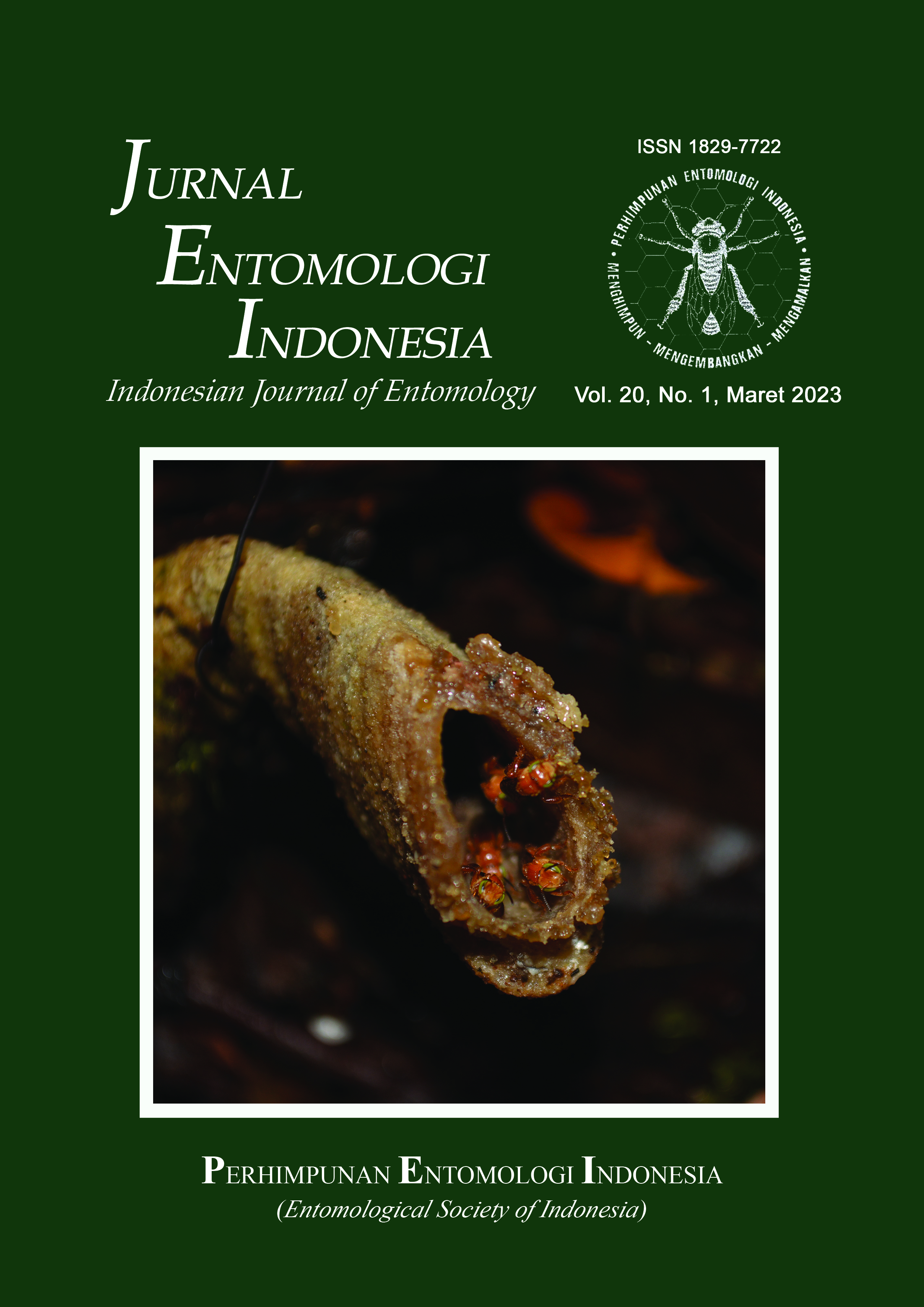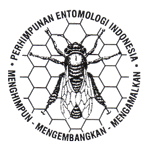Tropical lowland rainforest conversion to rubber monoculture affects flight activity and pollen resources of the stingless bees Tetragonula laeviceps
Konversi hutan tropis dataran rendah menjadi lahan monokultur karet mempengaruhi aktivitas terbang dan asupan sumber daya lebah tanpa sengat Tetragonula laeviceps
DOI:
https://doi.org/10.5994/jei.20.1.88Keywords:
bee pollen, converted land, flight activity, pollen resource, Tetragonula laevicepsAbstract
Tropical lowland rainforest conversion leads to decreases diversity and population in insect pollinators, including stingless bees. However, how stingless bees respond to this conversion is still being studied. In this study we observed the number of flight activities of the Tetragonula laeviceps (Smith) in three converted land types in Jambi, Sumatra; identified the pollen resources of T. laeviceps from the collected pollen in the hind tibia; and exploring the flowering plants surrounding the T. laeviceps nests. Four flight activities were observed, i.e., flying out of the nest, returning with pollen, returning without pollen, and returning with resin. In addition to the flight activity, we observed flight direction and environmental factors and identified pollen composition from the hind tibia of stingless bees. This study showed that forest fragments had the highest number of bees flying out of the nest. Bees returning with or without pollen in the fragmented forest with high coverage were higher than in other habitats. The highest number of bees returning with resin was found in the rubber plantation with high coverage, while the lowest number of all flight activities were observed in the shrub with low coverage. The stingless bees mainly collected pollen from rubber flowers supported by their flight directions leading to blooming rubber trees. Our study showed that the conversion of tropical lowland rainforests in this case rubber plantation affects on decreasing the flight activities and pollen collecting of stingless bees, which may have a significant impact on the resources needed by the bees.
Downloads
References
Adgaba N, Al-Ghamdi A, Tadesse Y, Getachew A, Awad AM, Ansari MJ, Owayss AA, Mohammed SEA, Alqarni AS. 2017. Nectar secretion dynamics and honey production potentials of some major honey plants in Saudi Arabia. Saudi Journal of Biological Sciences. 24:180–191. DOI: https://doi.org/10.1016/j.sjbs.2016.05.002.
Australian National University. 2018. Australasian Pollen and Spore Atlas. Available at: http://apsa.anu.edu.au/. [access September 2018].
Barnes AD, Jochum M, Mumme S, Haneda NF, Farajallah A, Widarto TH, Brose U. 2014. Consequences of tropical land use for multitrophic biodiversity and ecosystem functioning. Nature Communications. 5-5351:1–7. DOI: https://doi.org/10.1038/ncomms6351.
Basari N, Ramli SN, Khairi NASM. 2018. Food reward and distance influence the foraging pattern of stingless bee, Heterotrigona itama. Insect. 9:1–10. DOI: https://doi.org/10.20944/preprints201807.0036.v1.
Bates D, Machler M, Bolker BM, Walker SC. 2014. Fitting linear mixed-effects models using lme4. Journal of Statistical Software. 67:1–48. DOI: https://doi.org/10.18637/jss.v067.i01.
Bloch G, Bar-Shai N, Cytter Y, Green R. 2017. Time is honey: Circadian clocks of bees and flowers and how their interactions may infuence ecological communities. Philosophical Transactions of the Royal Society. B 372:20160256. DOI: https://doi.org/10.1098/rstb.2016.0256.
Brandenburg A, Dell’Olivo A, Bshary R, and Kuhlemeier . 2009. The sweetest thing advances in nectar research. Plant Biology. 12:486–490. DOI: https://doi.org/10.1016/j.pbi.2009.04.002.
Buchori D, Rizali A, Priawandiputra W, Sartiami D, Johannis M. 2019. Popultion growth and insecticide residue of honey bees in tropical agricultural landscapes. Diversity. 12:1–9. DOI: https://doi.org/10.3390/d12010001.
Brosi BJ. 2009. the complex responses of social stingless bees (Apidae: Meliponini) to tropical deforestation. Forest Ecology and Management. 258:1830–1837. DOI: https://doi.org/10.1016/j.foreco.2009.02.025.
Dirzo R, Raven PH. 2003. Global state of biodiversity and loss. The Annual Review of Environment and Resources. 28:137–67. DOI: https://doi.org/10.1146/annurev.energy.28.050302.105532.
Drescher J, Rembold K, Allen K, Beckschafer P, Buchori D, Clough Y, Faust H, Fauzi AM, Gunawan D, Hertel D, Irawan B, Jaya INS, Klarner B, Kleinn C, Knohl A, Kotowska MM, Krashevska V, Krishna V, Leuschner C, Lorenz W, Meijide A, Melati D, Nomura M, Cruzado CP, Qaim M, Siregar IZ, Steinebach S, Tjoa A, Tscharntke T, Wick B, Wiegand K, Kreft H, Scheu S. 2016. Ecological and socio-economic functions across tropical land use systems after rainforest conversion. Philosophical Transactions of The Royal Society. B 371:1–8. DOI: https://doi.org/10.1098/rstb.2015.0275.
Erdtman G. 1972. Pollen Morphology and plant Taxonomy. New York (USA): Hafner Publishing.
Gadhiya VC, Pastagia JJ. 2019 Time spent by stingless bees, Tetragonula laeviceps for nectar and pollen collection from musk melon flower. Journal of Entomology and Zoology Studies. 7:498–500.
Hrncir M, Silva CM, Teixeira-Souza VHDS, Imperatriz-Fonseca VL. 2019. Stingless bee and their adaptations to extreme environments. Journal of Comparative Physiology. 205:415–426. DOI: https://doi.org/10.1007/s00359-019-01327-3.
Heard TA. 1999. The role of stingless bees in crop pollination. Annual Review of Entomology. 44:183–206. DOI: https://doi.org/10.1146/annurev.ento.44.1.183.
Hilario SD, Imperatriz FVI, Kleinert A de M. P. 2000. Flight activity and colony strength in the stingless bee Melipona bicolor bicolor (Apidae: Meliponinae). Revista Brasileira de Biologia. 60:299–306. DOI: https://doi.org/10.1590/S0034-71082000000200014.
Jaapar MF, Nasarodin NS, Reward NF, Jajuli R, Ghani IA. 2018. Notes on resin collected by stingless bees in Taman Tropika Tasik Kenyir, Terengganu, Malaysia. Serangga. 24:81–89.
Kahono S, Chantawannakul P, Engel MS. 2018. Social bees and the current status of beekeeping in Indonesia. In: Chantawannakul P, Williams G, Neumann P. (Eds.), Asian Beekeeping in the 21st Century. pp. 287–306. Singapura: Springer Nature Singapore Pte Ltd. DOI: https://doi.org/10.1007/978-981-10-8222-1_13.
Kaluza BF, Wallace H, Heard TA, Klein AM, Leonhardt SD. 2015. Urban garden promote bee foraging over natural habitats and plantations. Ecology and Evolution. 6:1304–1316. DOI: https://doi.org/10.1002/ece3.1941.
Kevan PG. 1999. Pollinators as bioindicators of the state of the environment: species, activity and diversity. Agriculture, Ecosystems & Environment. 74:373–393. DOI: https://doi.org/10.1016/S0167-8809(99)00044-4.
Klein AM, Vaissiere BE, Cane JH, Dewenter IS, Cunningham SA, Kremen C, and Tscharntke T. 2007. Importance of pollinators in changing landscapes for world crops. Proceedings of the Royal Society B: Biological Sciences. 274:303–313. DOI: https://doi.org/10.1098/rspb.2006.3721.
Maia-Silva C, Hrncir M, da Silva CI, Imperatriz-Fonseca VL. 2015. Survival strategies of stingless bees (Melipona subnitida) in an unpredictable environment, the Brazilian tropical dry forest. Apidoslogie. 46:631–643. DOI: https://doi.org/10.1007/s13592-015-0354-1.
Madjid A, Maslichah Saleh D, Bunyamin. 1976. Experiment of flower induction in Hevea rubber. In: Paper presented at the Symposium of the International Rubber Research and Development Board, (Bogor, 8–9 November 1976). Bogor: Indonesian Biotechnology Research Institute for Estate Crops.
Martin P, Batteson P. 1993. Measuring Behaviour an Introductory Guide. Second edition. Cambridge: Cambridge Univ Press. DOI: https://doi.org/10.1017/CBO9781139168342.
Martins DJ. 2004. Foraging patterns of managed honeybees and wild bee species in an arid African environment: Ecology, biodiversity and competition. International Journal of Tropical Insect Science. 24:105–115. DOI: https://doi.org/10.1079/IJT200411.
Mudiyarso D, Noordwijk M Van, Wasrin, UR, Tomich TP, Gillison AN. 2002. Environmental benefits and sustainable land-use options in the Jambi transect, Sumatra. Journal of Vegetation Science. 13:429–438. DOI: https://doi.org/10.1111/j.1654-1103.2002.tb02067.x.
Nurwanda A, Zain AFM, Rustiadi E. 2016. Analysis of land cover changes and landscape fragmenta-tion in Batanghari regency, Jambi Province. Procedia-Social and Behavioral Sciences. 227:87–94. DOI: https://doi.org/10.1016/j.sbspro.2016.06.047.
Peng T, Pedrosa J, Batista JE, Nascimento FS, Gruter C. 2021. Foragers of the stingles bee Pleibeia droryana inform nestmates about the direction, but not the distance to food source. Ecological Entomology. 46:33–40. DOI: https://doi.org/10.1111/een.12937.
Putra DP, Dahelmi, Salmah S, and Swasti ME. 2016. Pollination in chili papper (Capsium annuum L.) by Trigona laeviceps and T. minangkabau (Hymenoptera, Meliponini). Journal of Entomology and Zoology. 4:191–194.
R Core Team. 2019. R: A language and environment for statistical computing. R Foundation for Statistical Computing, Vienna, Austria. Available at: https://www.R-project.org/. [access September 2018].
Ramadani RF, Raffiudin R, Ariyanti NS, Biagioni S, Treanore E, Behling H. 2021. Stingless bee foraging behavior and pollen resource use in oil palm and rubber plantations in Sumatra. Jurnal Entomologi Indonesia. 18:81–92. DOI: https://doi.org/10.5994/jei.18.2.81.
Rasmussen C. 2008. Catalog of the Indo-Malayan/Australasian stingless bees (Hymenoptera: Apidae: Meliponini). New Zealand: Magnolia press. DOI: https://doi.org/10.11646/zootaxa.1935.1.1.
Rembold K, Mangopo H, Tjitrosoedirdjo SS, Kreft H. 2017. Plant diversity, forest depency, and alien plant invasions in tropical agricultural landscapes. Biological Conservation. 213:234–242. DOI: https://doi.org/10.1016/j.biocon.2017.07.020.
Ricketts TH, Regetz J, Dewenter IS, Cunningham SA, Kremen C, Bogdanski A, Herren BG, Greenleaf SS, Klein AM, Mayfield MM, Morandin LA, Ochieng A, Vianna BF. 2008. Landscape effects on crop pollination services: are there general patterns?. Ecology Letters. 11:499–515. DOI: https://doi.org/10.1111/j.1461-0248.2008.01157.x.
Rivano F, Vera J, Cevallos V, Almeida D, Maldonado L, Flori A. 2016. Performance of 10 Hevea brasiliensis clones in Ecuador, under South American leaf blight escape conditions. Industrial Crops and Products. 94:762–773. DOI: https://doi.org/10.1016/j.indcrop.2016.09.035.
Schulze CH, Waltert M, Kessler PJA, Pitopang R, Shahabuddin, Veddeler D, Muhlenberg M, Gradstein SR, Leuschner C, Dewenter IS, and Tscharntke T. 2004. Biodiversity indicator groups of tropical land-use systems: comparing plants, birds, and insects. Ecological Applications. 14:1321e33. DOI: https://doi.org/10.1890/02-5409.
Siregar EH, Atmowidi T, Kahono S. 2016. Diversity and abundance of insect pollinators in different agricultural lands in Jambi, Sumatera. HAYATI Journal of Biosciences. 23:13–17. DOI: https://doi.org/10.1016/j.hjb.2015.11.002.
Zhang H, Zhou Z, An J. 2019. Pollen release dynamics and daily patterns of pollen-collecting activity of honeybee Apis mellifera and bumblebee Bombus lantschouensis in solar greenhouse. Insects. 10:216. DOI: https://doi.org/10.3390/insects10070216.
Published
How to Cite
Issue
Section
License
Copyright (c) 2023 Zumaida Nur Pulungan, Windra Priawandiputra, Ingo Grass, Kevin Li, Rusnia J Robo, Rika Raffiudin

This work is licensed under a Creative Commons Attribution 4.0 International License.
Authors who publish with this journal agree to the following terms:
- Authors retain copyright and grant the journal right of first publication with the work simultaneously licensed under a Creative Commons Attribution 4.0 International License that allows others to share the work with an acknowledgement of the work's authorship and initial publication in this journal.
- Authors are able to enter into separate, additional contractual arrangements for the non-exclusive distribution of the journal's published version of the work (e.g., post it to an institutional repository or publish it in a book), with an acknowledgement of its initial publication in this journal.
- Authors are permitted and encouraged to post their work online (e.g., in institutional repositories or on their website) prior to and during the submission process, as it can lead to productive exchanges, as well as earlier and greater citation of published work (See The Effect of Open Access).








